…were as close to the Earth as the International Space Station (ISS). Gravitational and tidal effects aside, this is a nice photorealistic animation to show the night during the day.
And, then…what if the Earth had rings like Saturn?
36.2055 years in science communication
…were as close to the Earth as the International Space Station (ISS). Gravitational and tidal effects aside, this is a nice photorealistic animation to show the night during the day.
And, then…what if the Earth had rings like Saturn?
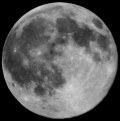 #18 It may seem obvious, but art does not always capture the true appearance of the Moon: where it is in the sky always tells you where the Sun is.
#18 It may seem obvious, but art does not always capture the true appearance of the Moon: where it is in the sky always tells you where the Sun is.
You will never see a crescent Moon looking like an open parachute: if the crescent is on its side, the "horns" will point upwards, indicating that the Sun is"below" the Earth’s horizon. A full Moon indicates that the Sun is "behind" the Earth.
Cecilia Payne-Gaposchkin, wrote in a 1954 astronomy textbook: "It is an amusing pastime to note the impossible moons portrayed by some artists: a new moon high in the northern sky, for instance; a full moon near sunset in the west; or a crescent with horns pointed downward."
Alice in Galaxyland: 38 things you might not know about the Moon.
As is obvious within a few seconds of having tweeted the map purportedly showing “every meteorite that has hit Earth since 2300 BC”, the map actually just shows where the people are and where people have recorded meteorite impacts.
The first comment on the Gizmodo item puts this quite succinctly”. It’s all the recorded meteorites. Not every meteorite. There’s a big difference. The data would skew very heavily to places where there was been human habitation, followed by exploration and cartography, and filtered for places like the Sahara and the ocean, where shifting terrain masks any prior impact site. In all, this would be a tiny sample of all the meteorites from the past 4312 years.”
In fact, statistically a meteorite is almost as likely to hit any spot on the Earth’s surface as any other, including the oceans and so the map would really look more like this:
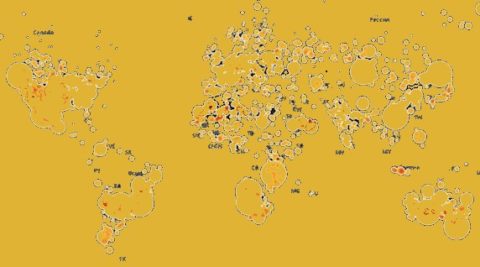
Presumably, the original map was generated to highlight the risk we face from incoming solar system shrapnel, especially in the wake of the recent Russian impact on the same day as an asteroid made a rather worryingly close flyby. Â One might even go so far as to say that it was somewhat sensationalist, scaremongering, even. It seems that humanity has a fixation on doomsday prophecies from the ancient god-given plagues, pestilence and thunderbolts from the blue, hell, devils, demons and ghosts and more recently alien invasions and nuclear war (that perhaps is a real threat) and even the Y2K bug (remember that?) and cyber war. Given that all of those those have generally turned out to be nothing but fantasy (with the exception of actual plagues) perhaps a cosmic collision is just the latest in a long line of unwarranted worries.
I can say that at least until a rather bigger chunk of rock hits a major city and triggers an unsupernatural armageddon. There are, after all, an estimated 100,000 to 1,000,000 chunks of rock flying around the sun that cross Earth’s orbit right now that we have never observed, but many more are flung in from the far-reaching corners of the solar system by the enormous gravitational fields of the gas giants Jupiter and (to a lesser extent) Saturn. Conversely, it may be that Jupiter actually protects us from debris. We might stand a chance of spotting an incoming asteroid with maybe three weeks to spare…would that be sufficient time for us to make a contingency plan, to hide under the bed or blast the rock apart?
“Soar through the universe with the Hubble Space Telescope, exploring discoveries from dark energy to colliding galaxies. This highly interactive eBook features video, image galleries and more to reveal the record of scientific breakthroughs behind Hubble’s stunning images of the cosmos.
Â
For more than two decades, Hubble has had a front-row seat for cosmic events: comets plunging into Jupiter, the explosive death of stars, the birth of new solar systems, and more. In the process, it has changed the face of astronomy. Learn about Hubble’s revelations and take a tour of the history and technology of the telescope.”
Free for you iPad via iTunes – Books – Hubble Space Telescope Discoveries by HubbleSite.org & WebbTelescope.org.
NASA’s venerable spacecraft, Voyager 1, has entered the farthest reaches of our solar system ahead of hitting interstellar space. Scientists refer to this new region as a magnetic highway for charged particles because our Sun’s magnetic field lines are connected to interstellar magnetic field lines. This connection allows lower-energy charged particles that originate from within the heliosphere to zoom out and lets higher-energy particles from outside stream in.
NASA Voyager 1 Encounters New Region in Deep Space – NASA Jet Propulsion Laboratory.
Earlier, I mentioned GalaxyZoo, the crowdsourced galaxy categorisation site, what I forgot to mention is the fact that there are galaxies to match every letter of the alphabet, which means there is a truly galactic font out there and the site’s creators have developed an app to let you write your own message in galacticalligraphy:
Obviously, first thing I wrote was a rude word, but I deleted that quickly and wrote “sciencebase” instead ;-) Click the graphic and it takes you to my page and then you can write a new message, such as “Hello World” or perhaps more appropriately, “Hello Worlds“. Have fun and do have a go on GalaxyZoo you might spot an entirely new galactic character.
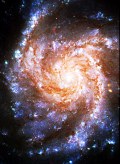 It’s been a while since I first mentioned the super amateur astronomy project Galaxy Zoo where members of the public get to classify galaxies and so help astronomers build a better view of the universe. September 2009 on SciScoop, in fact.
It’s been a while since I first mentioned the super amateur astronomy project Galaxy Zoo where members of the public get to classify galaxies and so help astronomers build a better view of the universe. September 2009 on SciScoop, in fact.
Roughly one hundred billion galaxies are scattered throughout our observable Universe, each a glorious system that might contain billions of stars. Many are remarkably beautiful, and the aim of Galaxy Zoo is to study them, assisting astronomers in attempting to understand how the galaxies we see around us formed, and what their stories can tell us about the past, present and future of our Universe as a whole.
The idea is based on the fact that you we tell an awful lot about a galaxy just from its shape. If you can spot a system with spiral arms, for example, then most of the time you’ll know that you’re looking at a rotating disk of stars, dust and gas with plenty of fuel for making new stars. Find one of the big balls of stars known as ellipticals, and you’ll most likely be looking at an old galaxy, one that no longer makes new stars.
The history of a galaxy is revealed by its shape. Ellipticals are usually formed by head-on collisions between two smaller galaxies, warped disks, large bulges or long streams of stars are testament to the complexity of galactic evolution.
Visit the site now and start classifying and you will see pictures of astronomical objects from the database of The Sloan Digital Sky Survey (SDSS) which started in 2000 and used a 126 megapixel imaging camera and two fibre-fed spectrographs, mounted on the dedicated 2.5 metre telescope at Apache Point Observatory in New Mexico to create a vast map of the night sky.
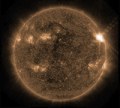 The sun is just a spinning ball of hot gas, 1.4 million kilometres across. The Deceived Wisdom about spinning balls if of course that they should bulge at their equator because of centrifugal force, the fast moving matter at the equator being flung out more than that at the North or South poles, like kids on the edge of a roundabout rather than those clinging to the middle.
The sun is just a spinning ball of hot gas, 1.4 million kilometres across. The Deceived Wisdom about spinning balls if of course that they should bulge at their equator because of centrifugal force, the fast moving matter at the equator being flung out more than that at the North or South poles, like kids on the edge of a roundabout rather than those clinging to the middle.
Indeed, astronomers had always expected our nearest star to bulge slightly at its equator. The gas giant planet Jupiter (which shone so brightly alongside Venus and the crescent moon in the morning sky the other is very oblate because of this phenomenon. Jupiter rotates on its axis once every 10 hours (its day is less than half as long as an Earth day). This makes it almost 7% wider across its equator than the distance from pole to pole, explains The Guardian. It’s very oblate. The Earth too is flattened by its spin making it an approximate oblate spheroid rather than a perfect sphere. Measure its diameter through the poles and it is about 12,715 km, but the equatorial diameter is 12,756 km). One would expect the Sun to have a significant difference too, given that it is so much bigger, although the Sun takes about five Earth weeks to spin on its axis once.
However, a team at the University of Hawaii has now pinned down the first precise measurements of the Sun’s equatorial bulge as part of a 50-year ongoing effort. Surprisingly, results show that the Sun does not have as big an equatorial bulge as one might expect. The difference between equatorial and polar diameter is more than 41 km. The difference for the Sun is a fraction of that at a mere 10 kilometres. In percentage terms the difference on Earth is almost a third of one percent. For the Sun, it’s a tiny 0.0007%.
Research team leader Jeffrey Kuhn and colleagues suggest that this makes the Sun the most near-perfect sphere. According to the Guardian if one were to scale the Sun to the size of a beachball the difference would be less than that of the proverbial human hair. “Only an artificial sphere of silicon that was created as a standard for weights is known to be more perfectly spherical,” the report says.
The explanation for this near perfection might lie in the fact that although the Sun’s total rotation is about 34 Earth days, the outer surface layers may not be rotating at the same rate. “The solar oblateness is substantially lower than theoretical expectations by an amount that could be accounted for by a slower differential rotation in the outer few percent of the Sun,” the team reports in the journal Science.
![]() Kuhn, J.R., Bush, R., Emilio, M. & Scholl, I.F. The Precise Solar Shape and Its Variability, Science, DOI: 10.1126/science.1223231
Kuhn, J.R., Bush, R., Emilio, M. & Scholl, I.F. The Precise Solar Shape and Its Variability, Science, DOI: 10.1126/science.1223231
But, why are stars and planets “spherical” in the first place? According to a SciAm Q&A: “Planets are round because their gravitational field acts as though it originates from the centre of the body and pulls everything toward it. Over long periods of time the stuff from which the planet is made succumbs to the gravitational pull from its centre of gravity so that any protuberances are smoothed out. The process is known as “isostatic adjustment.” The process requires that the mass of the astronomical object be large enough that gravity can do this, which is why asteroids tend to stay lumpy their smaller gravitational field is not big enough to pull them into a spherical shape.
I woke rather earlier than usual this morning (about 4:30 to be precise) and took a look eastwards from our bedroom window and what a spectacle! Despite the early hour, I grabbed my SLR and snapped the crescent Moon, Venus and Jupiter in near alignment. I posted the raw photo on Imaging Storm, but have done a labelled version for Sciencebase readers:
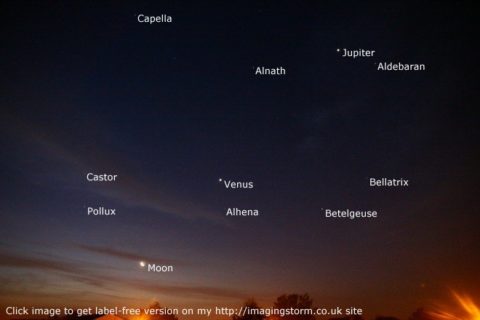
Skymania’s Paul Sutherland tells us that Venus currently makes “a brilliant spectacle in the morning sky” and I’d have to agree it was quite a site, crisp, clear, earthshine apparent in the horns of the crescent moon. Venus is also presenting a crescent but is big in the sky because it is slightly closer to us than at other times. Similarly, Skymania says “Jupiter is easy to see in the morning sky now, shining brightly in the constellation of Taurus”. If you have binoculars or a small telescope you will easily see its largest moons and maybe even details on the planet’s gaseous surface too.Skymania News and Guide — The night sky in August — northern hemisphere.
Let’s zoom in on the supermassive blackhole at the centre of our galaxy, the Milky Way…
This zoom sequence starts with a view of the Milky Way. We zoom in towards the crowded central region, in the constellation of Sagittarius (The Archer). By shifting to an infrared view we see through the dusty clouds in this direction and get a closeup of the objects orbiting the supermassive black hole that lies at the centre of the Milky Way. The final views show the motion of a recently discovered gas cloud that is falling rapidly towards the central black hole.
Credit: ESO/MPE/Nick Risinger (skysurvey.org)/VISTA/J. Emerson/Digitized Sky Survey 2